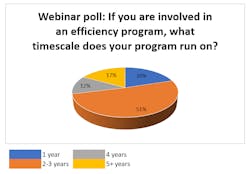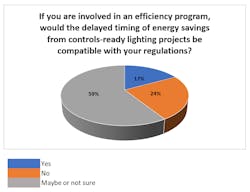In a webinar on September 6, DesignLights Consortium (DLC) senior technical manager Levin Nock explained the results of a study examining energy efficiency and networked lighting controls (NLC). DLC defines NLC as the combination of sensors, network interfaces, and controllers that affect lighting changes to luminaires, not including luminaires themselves.
As part of its nonprofit mission, DLC investigates and informs North American lighting and controls stakeholders, utilities, government regulators, and efficiency programs on ways to manage energy consumption, improve light quality, and enhance the occupant experience in the built environment. Its initiatives include lighting and controls specifications through its Qualified Products Lists, independent studies, and educational resources.
The DLC study explored the energy savings potential of two scenarios — one in which NLC are installed at the time of LED luminaire installation, and one in which NLC-capable LEDs are installed, but NLC are added five years after the initial LED installation. Researchers also examined the difference NLC made when combined with other systems — specifically heating, ventilation, and air conditioning (HVAC) systems. The baseline for both scenarios was an LED luminaire without NLC.
The team worked under the presumption that lighting would be retrofitted about once per decade and drew from many datasets. They also looked at different areas of the country; as energy costs fluctuate regionally, the results indicated higher savings in some areas compared to others.
In the webinar, Nock referenced an American Council for an Energy-Efficient Economy (ACEEE) report by Mike Specian and Aimee Bell-Pasht that indicated that the value of energy savings from energy efficiency is likely to rise over time.
Framing the study
The study was based on a deep dive into two states: Arizona and Connecticut. Using multiple datasets, researchers modeled the energy usage of all commercial buildings in each state. Buildings were divided into three categories based on size: Buildings under 25,000 square feet were considered small buildings; those between 25,000 and 50,000 square feet were labeled as medium; and buildings with more than 50,000 square feet were considered large.
Building types included in each size division were:
- Small: Education, hospital, hotel, office, outpatient, quick-serve restaurant, full-serve restaurant, retail standalone, warehouse, and retail strip mall.
- Large: Hospital, education, hotel, office, outpatient, retail standalone, retail strip mall, and warehouse.
- The models determined that medium buildings behaved like large ones. HVAC integration was not considered for these, however, because no plug-and-play solution was available.
With this data, the researchers then played out the two aforementioned scenarios. The first scenario looked at the differences between integrating NLC alone versus NLC installed with demand response (DR), plug load, or HVAC.
The second scenario looked at the effects of installing controls-ready luminaires (with standardized D4i drivers and Zhaga sockets) and then integrating NLC five years after installation.
Researchers found that 60% of large buildings matched the criteria for NLC HVAC integration but noted that this number could be better refined by future work.
Analyzing the results
For the question, “What makes incentives for NLC a sound investment for efficiency programs?” the researchers found that in Connecticut, NLC alone, when installed with a lighting upgrade, are cost-effective in most small buildings, as well as in large retail and hospital buildings. A utility costs test found a benefit/cost ratio of 1 to 3. The addition of DR benefited the same building types as NLC alone, with the addition of small warehouses, large offices, and large outpatient facilities. This again presented a benefit/cost ratio of 1 to 3. NLC with the addition of HVAC were found to be effective for most buildings, with a benefit/cost ratio between 3 and 6, indicating that the value of the benefit is significantly higher than the cost.
In Arizona, it was found that incentivizing NLC alone during a lighting upgrade only makes sense in quick-serve restaurants, retail standalone, and retail strip malls. A 1 to 3 benefit/cost ratio was calculated.
NLC installed with DR added only one more building type to the list, small hospitals, and maintained a benefit/cost ratio of 1 to 3. The addition of HVAC made NLC incentives viable in all large building types, except for warehouses, with a benefit/cost ratio of 1 to 3.
Results indicated that NLC present significant energy savings potential. In the “optimistic” scenario, commercial building electrical consumption was reduced by nearly 10% in Connecticut and 5% in Arizona by 2030. Peak demand by 2030 was reduced by approximately 1.8% in Connecticut and 0.7% in Arizona. Integration of NLC with HVAC systems found a 1.3% and 0.5% reduction in natural gas consumption in Connecticut and Arizona, respectively.
Results also showed similar maximum cumulative potential for savings in both the NLC replacement and controls-ready replacement scenarios, with the difference that maximum savings are achieved five years later in the latter scenario.
In both regions, HVAC integrated with NLC passed the Societal Cost Test. Buildings with high light power density and variable occupancy were the most favorable in terms of energy savings.
Overall energy savings potential of NLC
The researchers then asked, “Would the benefits of NLC be large enough for utilities to notice?” The study found that if the states were able to acquire all the cost-effective savings from NLC, Connecticut would have a nearly 10% savings, and Arizona would have nearly 5%, compared to the 2020 total sales of electricity. The net energy efficiency benefits would be valued at $1.2 billion in Connecticut and $217 million in Arizona.
During the webinar, Nock compared the total greenhouse gas emissions avoided over six years (2024–2030) to the emissions avoided by installing wind turbines. It was determined that in Connecticut, the energy savings would cut the same amount of emissions as building 35 wind turbines and running them for the following six years. In Arizona, the emissions reduction was comparable to building 47 wind turbines and operating them for six years.
A recording of the webinar can be found here.
Webinar poll results
HAYDEN BEESON is a writer and editor with over seven years of experience in a variety of industries. Prior to joining Endeavor Business Media as associate editor of Architectural SSL and LEDs Magazine, he was the managing editor of several machine reliability publications.
Follow our LinkedIn page for our latest news updates, contributed articles, and commentary, and our Facebook page for events announcements and more. You can also find us on the X platform.
Hayden Beeson
HAYDEN BEESON is a writer and editor with over seven years of experience in a variety of industries. Prior to joining Endeavor Business Media as associate editor of Architectural SSL and LEDs Magazine, he was the managing editor of several machine reliability publications.







